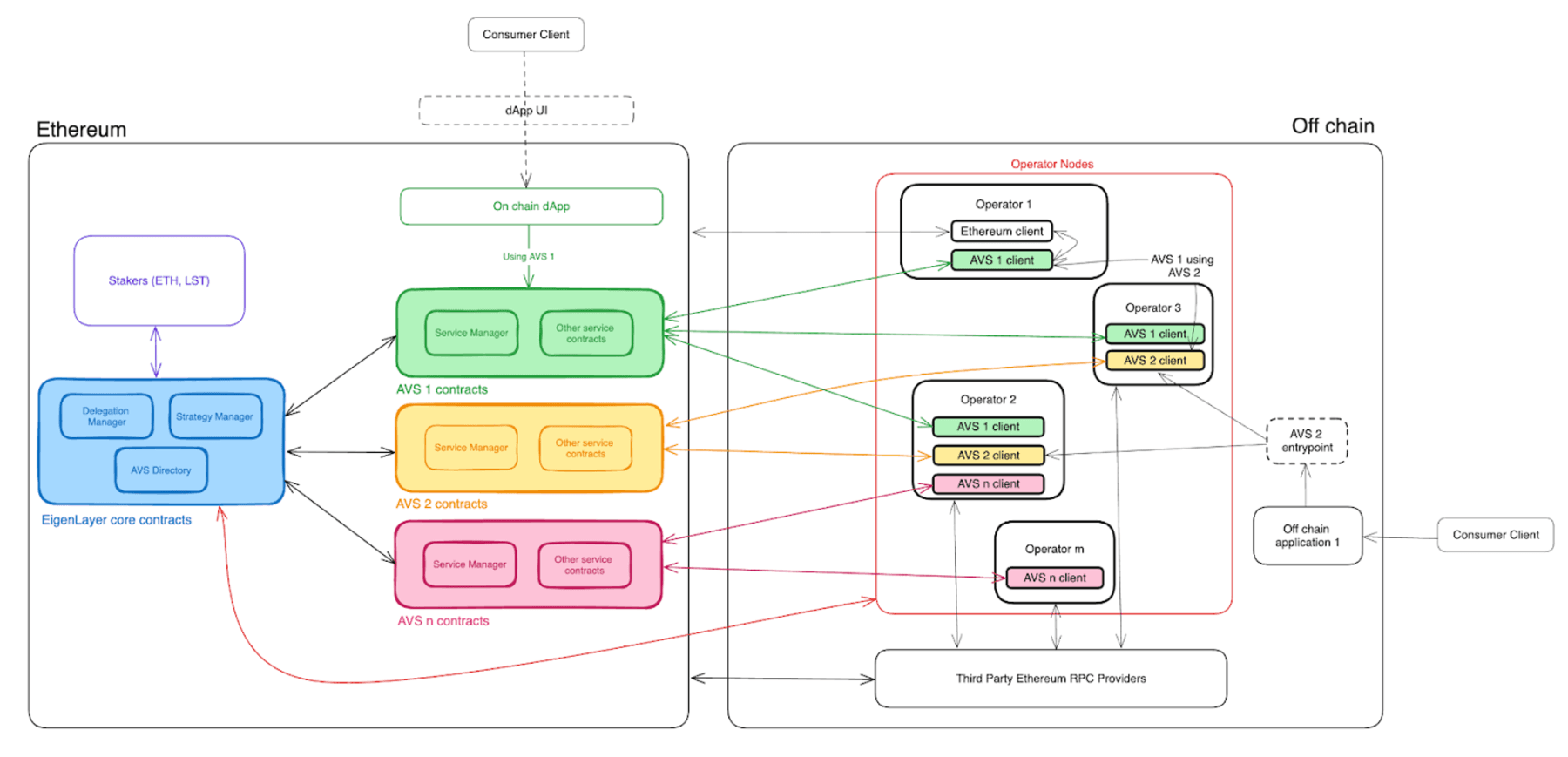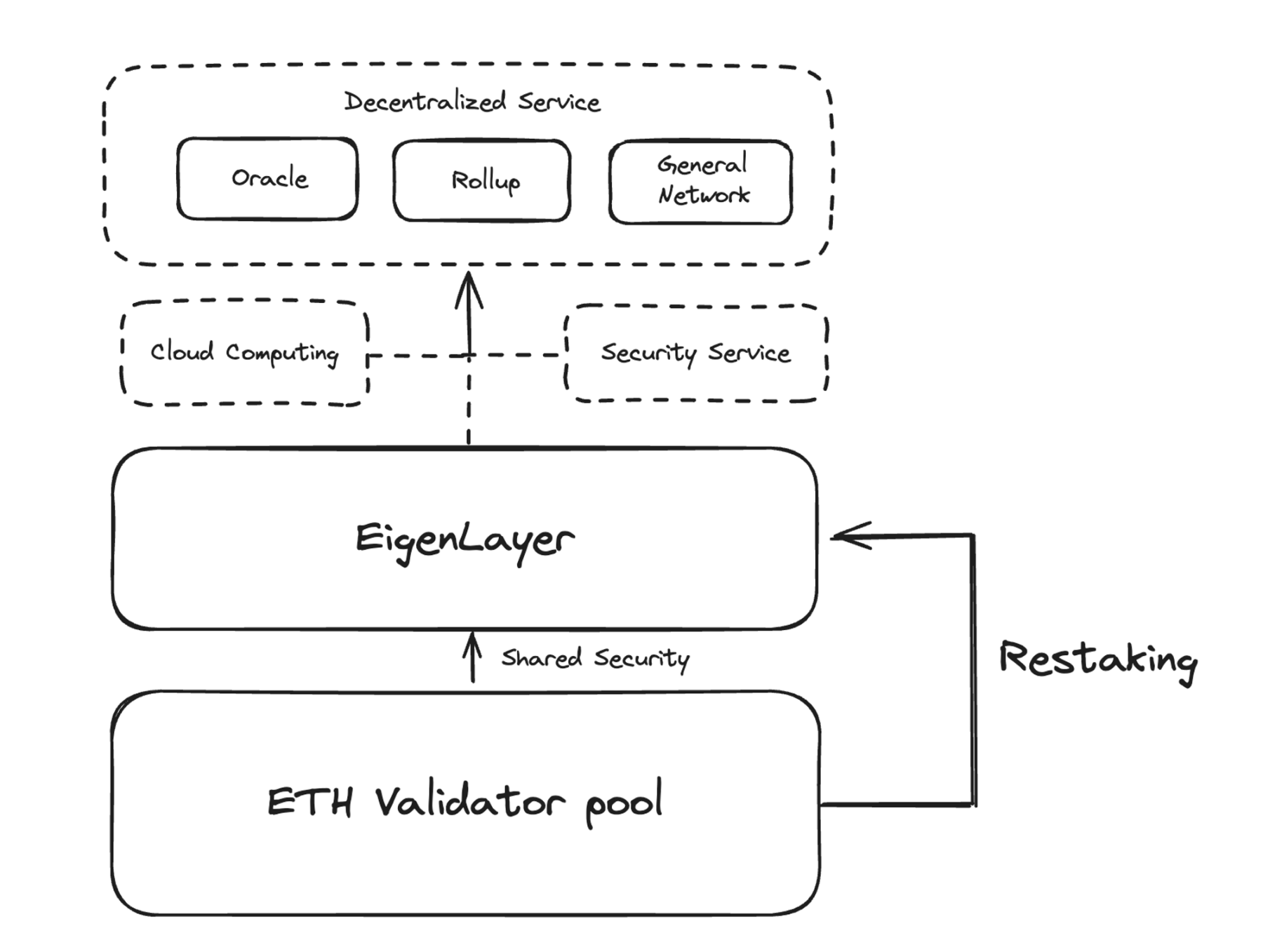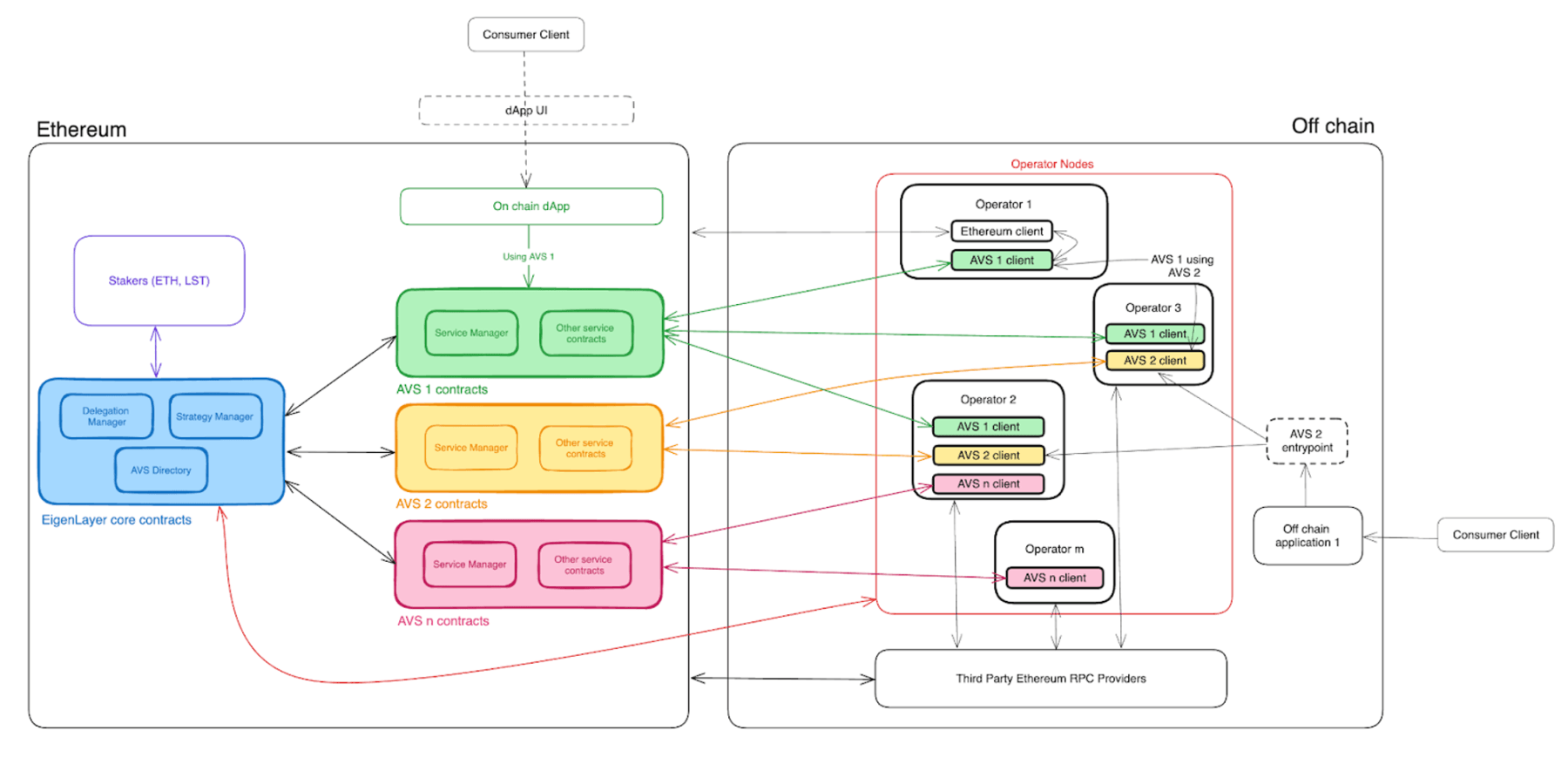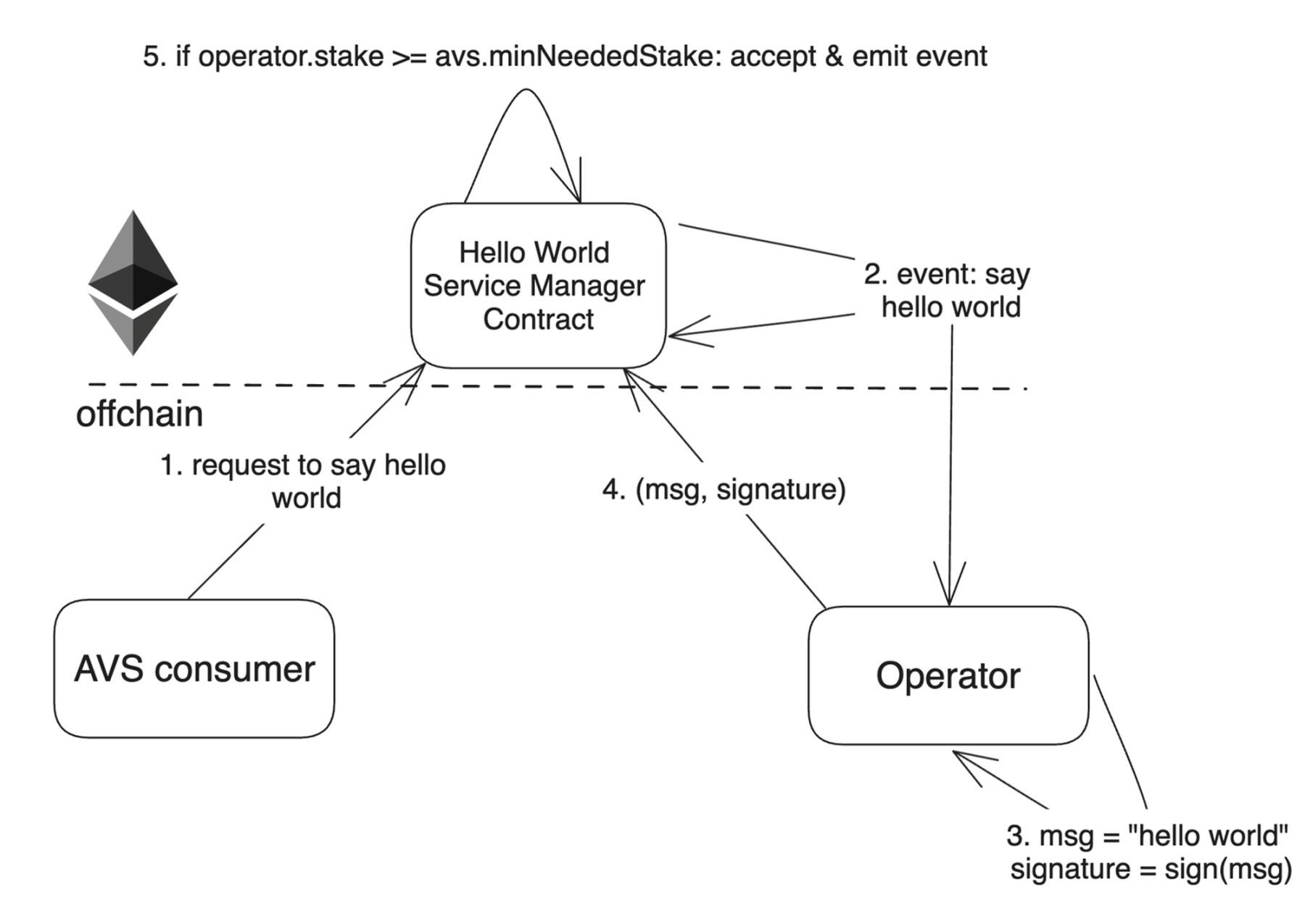Navigating EigenLayer: A Comprehensive Guide to AVS Design and Development

Series: Crypto Clarity Corner
- Navigating EigenLayer: A Comprehensive Guide to AVS Design and Development
- Unraveling Mina Protocol and ZKP Mysteries
Background
EigenLayer has emerged as a powerhouse in the Ethereum ecosystem, amassing over $10 billion in Total Value Locked (TVL) since its inception. While often perceived as merely a financial tool due to its "Restaking" feature, EigenLayer's true essence extends far beyond simple yield enhancement. At its core, EigenLayer represents a paradigm shift in cloud computing infrastructure, ingeniously merging financial incentives with distributed computing resources. Unlike traditional centralized cloud services like AWS or GCP, EigenLayer pioneers a decentralized approach to resource allocation and management. This novel infrastructure leverages the power of blockchain economics to create a robust, scalable, and efficient computing network. By allowing users to re-stake their Ethereum or Liquid Staking Tokens (LSTs), EigenLayer not only provides additional income streams but also fuels a new generation of decentralized services. In this exploration, we'll unravel the intricate mechanics behind EigenLayer's revolutionary model. Drawing from months of hands-on development, we'll also share insights on building decentralized networks atop EigenLayer and designing Actively Validated Services (AVS). This journey will illuminate how EigenLayer is reshaping the landscape of both blockchain technology and cloud computing, paving the way for a more decentralized and efficient digital future.
What is EigenLayer?🧩
EigenLayer stands as a groundbreaking innovation within the Ethereum ecosystem, reimagining the relationship between asset holders, developers, and blockchain security. At its core, EigenLayer introduces the concept of "Restaking," a mechanism that transforms the traditional notion of cryptocurrency staking into a multifaceted, value-generating process. For Ethereum asset holders, EigenLayer opens up a new realm of possibilities. Beyond the conventional staking rewards, it allows users to leverage their staked assets as a form of collateral to support emerging projects within the ecosystem. This dual-purpose utilization of assets not only enhances the potential returns for users but also contributes to the overall robustness of the Ethereum network and its associated projects. From a developer's perspective, EigenLayer serves as a game-changing platform. It effectively eliminates one of the most significant barriers to entry in blockchain development: the need to build and maintain a secure consensus mechanism from the ground up. By tapping into EigenLayer, developers can access a pre-established, highly secure network infrastructure. This allows them to channel their resources and creativity into the core functionalities of their decentralized applications, rather than grappling with the complexities of network security. In essence, EigenLayer acts as a bridge, connecting the formidable security apparatus of Ethereum with a diverse array of projects that require robust network consensus. It's akin to a decentralized, blockchain-native cloud computing service, but with an added layer of economic incentives baked into its very foundation. This unique approach not only fosters innovation but also creates a more interconnected and secure Ethereum ecosystem, where the success of individual projects contributes to the strength of the entire network.

What the heck is AVS and How Does it Work? 🔍🔐
Actively Validated Services (AVS) represent the cornerstone of the EigenLayer ecosystem, serving as the practical manifestation of its innovative infrastructure. In essence, an AVS is any protocol, service, or system that leverages staked assets to validate specific tasks, thereby ensuring the integrity and reliability of its operations. Imagine AVS as the decentralized counterpart to traditional cloud services in the Web2 world. Just as cloud computing extended the capabilities of on-premises systems, AVS expands the reach of blockchain technology beyond pure on-chain computations into the realm of off-chain, distributed computing. This extension is what Vyas Krishnan aptly describes as "Converting crypto to cloud." To illustrate the concept, consider a decentralized price oracle network. In this scenario, an AVS could be deployed to maintain the accuracy and trustworthiness of price data. Participating nodes would be required to stake a predetermined amount of assets, effectively putting their own resources on the line as a guarantee of their honest behavior. The AVS would then implement a consensus mechanism to validate the price reports broadcast by these nodes, ensuring the reliability of the data provided. At the heart of each AVS lies its Service Manager, a smart contract that acts as the liaison between the service and the EigenLayer infrastructure. This manager oversees critical aspects of the service, including:
- Communication with EigenLayer contracts
- Maintenance of service-related states
- Tracking of operators running the service
- Management of staked assets used to secure the service
The operational flow of an AVS within the EigenLayer network typically follows these steps:
- Staking: Operators stake their assets through EigenLayer.
- Registration: The AVS registers with EigenLayer, defining its validation parameters.
- Task Execution: The AVS performs its designated tasks (e.g., price reporting).
- Validation: EigenLayer's network validates the tasks according to the AVS's predefined rules.
- Reward/Penalty: Based on performance, operators receive rewards or face penalties.
This mechanism creates a self-regulating system where economic incentives align with service integrity, fostering a robust and reliable decentralized infrastructure. By leveraging EigenLayer's shared security model, AVS can focus on delivering specialized services without the overhead of building a secure consensus mechanism from scratch. In essence, AVS represents the practical application layer of EigenLayer, where the theoretical benefits of restaking and shared security manifest in tangible, real-world services. It's the bridge that connects the robust security of Ethereum with the diverse needs of decentralized applications, paving the way for a new generation of blockchain-powered services.

- To use EigenLayer, projects must develop an AVS client and ServiceManager contract. The client is the service to be validated by network nodes. The ServiceManager contract defines node participation conditions, rewards, and penalties, including staking requirements and interfaces for indexing and communication with the EigenLayer main contract.
- Network participants, called "Operators," run and maintain nodes. They must meet ServiceManager criteria and can stake their own tokens. Regular users can delegate tokens to Operators to earn additional income from the network.
- Once the AVS is set up and nodes are recruited, the network's services become available for use. The process of calling an AVS service is illustrated in an official diagram.

The Service Manager triggers off-chain computation via an event. Operators perform the computation, sign the result, and return it to the contract. However, AVS usage can be more flexible:
- AVS can be triggered directly through Operator nodes' public gateways, bypassing the Service Manager. Authentication is required to prevent spam.
- An aggregator is needed to report results and achieve consensus, as multiple nodes may run the same call for improved service availability.
- The Service Manager interacts with the EigenLayer contract based on reported results to reward or penalize nodes.
Design Principles and Concepts of AVS ✨
Before designing your own AVS, I think most developers need to consider the following questions:
- The service demand and type of the project itself
Understanding the type of service provided by the project is the basis for designing AVS because it directly affects:
Necessity: Whether the computation itself cannot be executed on-chain or is too costly. If the on-chain contract can complete the validation, the necessity of using AVS can be considered.
Validation logic: Different services require different validation methods. For example:
- Oracle services may require validation of consistency from multiple data sources
- DA services require validation of data storage and retrieval
- On-chain risk control requires simulation and review of transactions, requiring real-time efficiency and accuracy.
Performance requirements: The service type determines the requirements for speed and throughput. For example:
- Real-time on-chain risk control services require extremely low latency
- AI services require a large amount of GPU computing power
Security model: Different services face different security threats, affecting the design of the penalty mechanism. For example:
- Financial services may require stricter security measures and higher penalties
- Content distribution services may focus more on tamper resistance and availability
Node requirements: The service type determines the hardware and software requirements for nodes. For example:
- Compute-intensive services require high-performance servers
- Storage-intensive services require large-capacity storage
- How to penalize malicious nodes
This question directly relates to the security and reliability of AVS. Developers need to design an effective penalty mechanism to maintain the security and stability of the network. This includes:
- Defining what behavior is considered "malicious"
- Setting appropriate penalty severity, which should be deterrent enough without causing a significant decrease in node participation
- Designing a fair and transparent judgment and execution mechanism
A reasonable penalty mechanism can effectively reduce the motivation for node malfeasance and ensure the long-term healthy operation of the network.
- The profitability of the service itself and the budget to pay for "shared security"
This question involves the economic sustainability of AVS. Developers need to evaluate:
- Profit model and expected income of the service, or how to integrate with Tokenomics in the early stages of the project to provide sufficient expected rewards through token inflation
- Operating costs, including infrastructure, maintenance, etc.
- Reward budget that can be allocated to nodes and stakers
A reasonable economic model can ensure that AVS can attract and retain enough nodes and stakers while maintaining the sustainable development of the project.
- Network Scale Needed
The network scale directly affects the performance, decentralization, and security of AVS:
- Smaller networks may be easier to manage but may sacrifice some decentralization
- Larger networks may provide higher security but may increase complexity and costs
Developers need to find the best balance based on service requirements and resource constraints.
Only by carefully considering these issues, I believe it is possible to design a good and highly participatory AVS and avoid significant problems that may arise later due to insufficient consideration.
